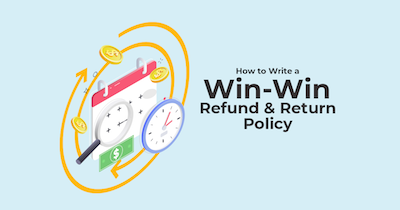A lot has already been said about the return policy for Ecommerce stores. However, sometimes, it is difficult to stick to the basics. After all, why you need one, where it should be displayed, what it needs to include, are all questions that we keep getting. So, today, we wanted to ensure that you can actually get all this information in just one place.

Discover everything you need to know about product returns.
Quick FAQs On Return Policy For Ecommerce Stores
#1: Do I Need To Have A Return Policy?

While there is no law that makes you have a return policy, the truth is that we believe that all online stores should include one. The main reason is to ensure that you can enforce your terms and parameters in what concerns returns and refunds.
One of the things that you need to keep in mind is that different states have different rules. For example, in the state of New York, if a retailer does not provide a Return & Refund Policy, the retailer will be required to accept returns and give refunds for all merchandise returned within 30 days of purchase. If you wish to limit this in any way, you will need to create and post a Return Policy with your own custom terms.
If you don’t have a Return Policy in place yet, you may be at the mercy of state laws regulating return and refund timeframes. You may also lose potential customers who are concerned about not being able to return a product if they need or want to.
Discover how to improve your return policy.
#2: What Are The Main Benefits Of Having A Return Policy?
The truth is that there are 2 main benefits of having a return policy for Ecommerce stores in place. The first one is the fact that you are the one who controls your return terms as we mentioned above. The second reason is the fact that by having a return policy for Ecommerce stores, your potential customers will have more confidence and will be more likely to buy from you.
Take a look at the consumer rights.
#3: What Information Should I Include In My Return Policy?

Overall speaking, return policy for Ecommerce stores should include the following information:
- How many days customers have to initiate a return
- How they should initiate a return
- Conditions of returns (must be unworn, in original packaging, etc.)
- Restrictions on returnable items (no returns on software or undergarments, etc.)
- What form you provide a refund in (original form of payment, store credit only, etc.)
- What party pays return shipping costs
- If you have any restocking or other fees you deduct from refunds
Learn more about how to deal with returns in retail.
#4: Where Do I Display My Return Policy?

You should always ensure that your Return Policy is always visible to your visitors. So, you can add a link to it on your website footer, for example, next to other important legal agreements and policies.
You may also consider adding a link to your Return Policy at the final checkout screen. This way, you are giving the opportunity to your buyers to read it again before they make the purchase.